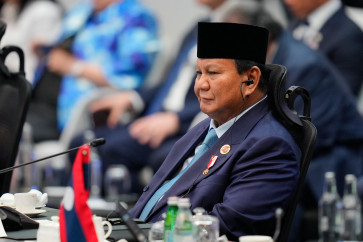Popular Reads
Top Results
Can't find what you're looking for?
View all search resultsPopular Reads
Top Results
Can't find what you're looking for?
View all search resultsSitras AnjIlin: Holding on to tradition
JP/Ganug Nugroho AdiResidents of Tutup Ngisor live for the arts
Change text size
Gift Premium Articles
to Anyone
J
a href="http://">JP/Ganug Nugroho AdiResidents of Tutup Ngisor live for the arts.
But forget about blaring loudspeakers in this little Central Javanese hamlet on the slope of Mount Merapi in Sumberan village, Dukun district, Magelang regency.
People there prefer to express their artistic penchant with melodies of mildly played gamelan and sounds of a flute and sung poetry.
“Not a day goes by without poetry singing and gamelan playing in Tutup Ngisor. We play anytime, because art has become part of people’s life around here,” said Sitras Anjilin recently.
Sitras Anjilin inherited Padepokan Tjipto Boedojo, a traditional studio in Tutup Ngisor, which his father Yoso Sudarmo — also known as Romo Yoso — established to revitalize Javanese traditional arts from 1937 onward. This studio has since served as an art center for the hamlets’ residents.
Born there in 1959, Sitras knows only too well traditional arts like the wayang orang (dance-drama based on adapted Hindu epics), gamelan music, jathilan (bamboo horse dance) and nembang (poetry singing), which he mostly learned from his father. His mother, Tentrem, used to help sew wayang orang costumes.
Two years after Romo Yoso died in 1990, Sitras, the youngest of seven siblings, took over the art studio from his older brother, and set out on a mission to continue preserving traditional arts in his community.
“After Romo’s demise, our padepokan went through difficult times. In 1992, the pavilion where residents trained had to be demolished because it was falling apart.
Actually we had no money to rebuild it,” recalled Sitras at the Sukuh temple arts meeting in Karanganyar, Central Java.
Along with his older brother Bambang Tri Santoso and studio members, Sitras performed in a number of art events in other areas to raise funds and establish broader connections with different art
circles.
“In 1997, Pak Widayat, the late painter, contributed Rp 40 million to renovate the pavilion, build a gamelan room and a wayang orang performance stage,” Sitras went on.
After the center was rebuilt, many people visited and stayed at the studio to experience the art activities local residents organized. Some of them also learned to play gamelan and wayang orang along with the villagers, who were all farmers. Tjipto Boedojo came to life again.
Tutup Ngisor has around 200 residents mostly involved in traditional arts. Every Thursday evening they play gamelan in the pavilion of padepokan, which they call caosan or an offering to nature and ancestors.
They also practice gamelan music, wayang orang and jathilan anytime they feel like it.
Meanwhile, on four occasions, Suronan Tutup Ngisor (15th Suro in the Javanese calendar), Mauludan (Prophet Muhammad’s birthday), Idul Fitri and the National Independence Day (Aug. 17), the villagers organize performances including horse and mask dances, enlivened by traditional music shows from various cities like Solo, Yogyakarta, Surabaya, Semarang, Jepara and Magelang.
“Residents don’t receive any government funding to organize these festivities in Tutup Ngisor. But luckily former neighbors and students of Romo Yoso now living in different cities donate funds,” said the longhaired man.
According to Sitras, Tutup Ngisor villagers’ approach to art is simple. They deem it is important to get involved in an artistic endeavor every day. Being engaged in art is as ordinary as farming, repairing damaged village paths, cooking or taking a bath.
Romo Yoso lives by the following words: “Urip iku aja pisan-pisan ninggalke seni” (Art must never be abandoned in life). His studio’s compulsory shows should be understood as basic art education to be undertaken throughout generations.
“Art provides villagers with energy, happiness and helps them make their dreams come true. Art is useful for their life force, as Romo also maintained that life and art should go hand in hand,” added Sitras.
The husband of Mardiyah never thought he would one day be heading this padepokan.
“I was only schooled until second grade. I never studied management. So I relied on my friends’ advice,” said Sitras, who dropped out of school because of illness.
Sitras’ friends and connections convinced him to go to Britain as a dance instructor in 2008. With a free-movement artist from Solo named Suprapto Suryodarmo, Sitras staged short wayang kulit (shadow puppet) shows in seven primary schools in Brighton, Britain, in 2010.
Sitras also pioneered teaching traditional arts to children in his community.
In the past, local children were not allowed to train before finishing junior high school because it was believed formal education was more important.
“But it’s hard to pick up gamelan music after junior high school.
People are no longer physically flexible. Learning traditional arts doesn’t interfere with the children’s education.”
Under his direction, Tutup Ngisor has frequently joined diverse programs like the Jakarta Art Festival, the Five Mountains Festival of Magelang and performances in Solo, Bandung, Yogyakarta, Surabaya as well as on the island of Bali.
The hamlet’s specialty is wayang orang. His studio has also promoted wayang menak, similar to wayang golek (wooden puppets). Wayang menak stories tend carry Islamic values and messages.
“I’ve just been doing what I’m supposed to, to build this studio. If traditional art is to survive in Tutup Ngisor, I’ve got to be immersed in the art there.”










